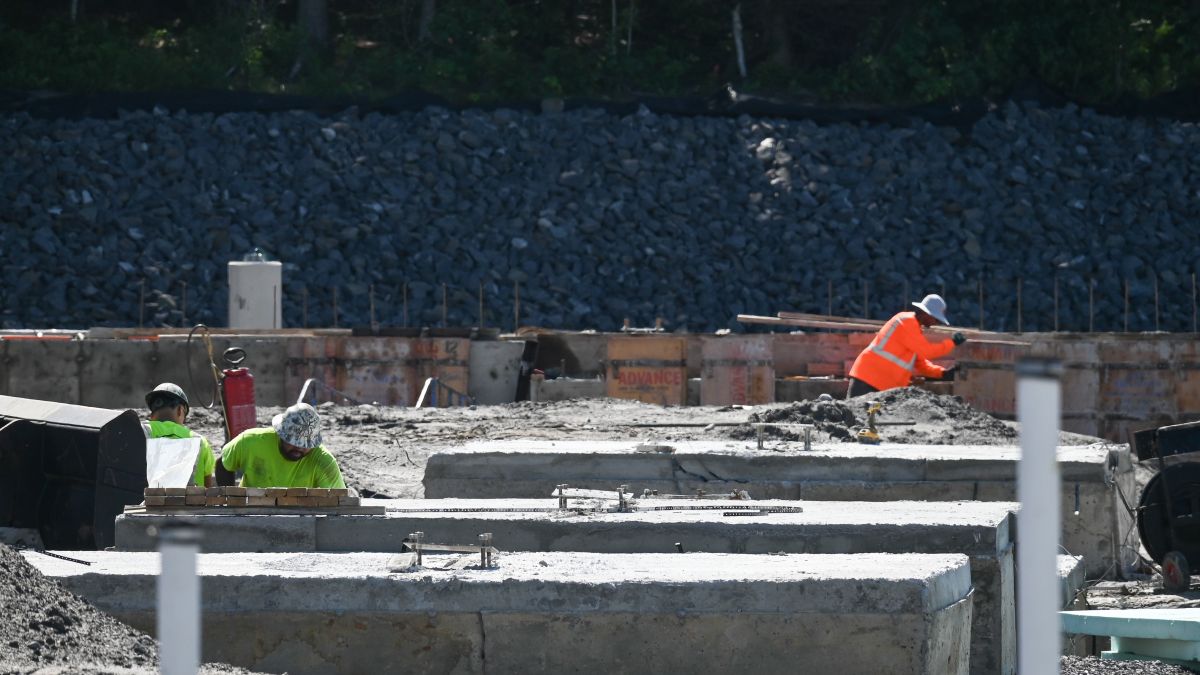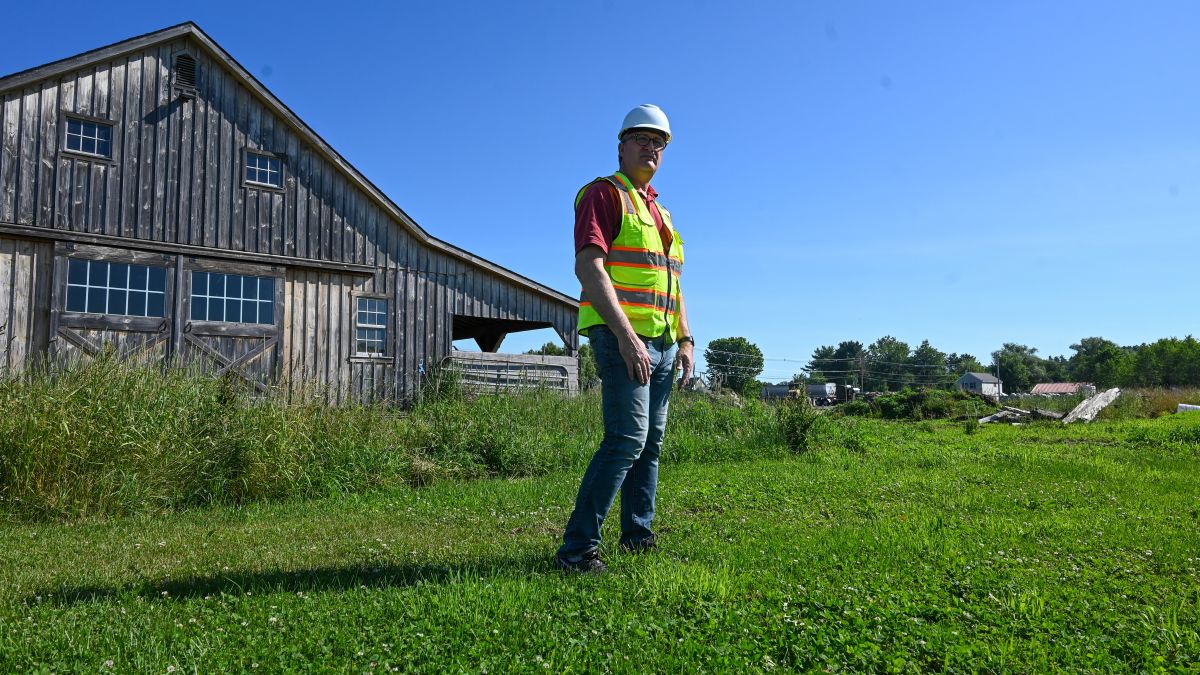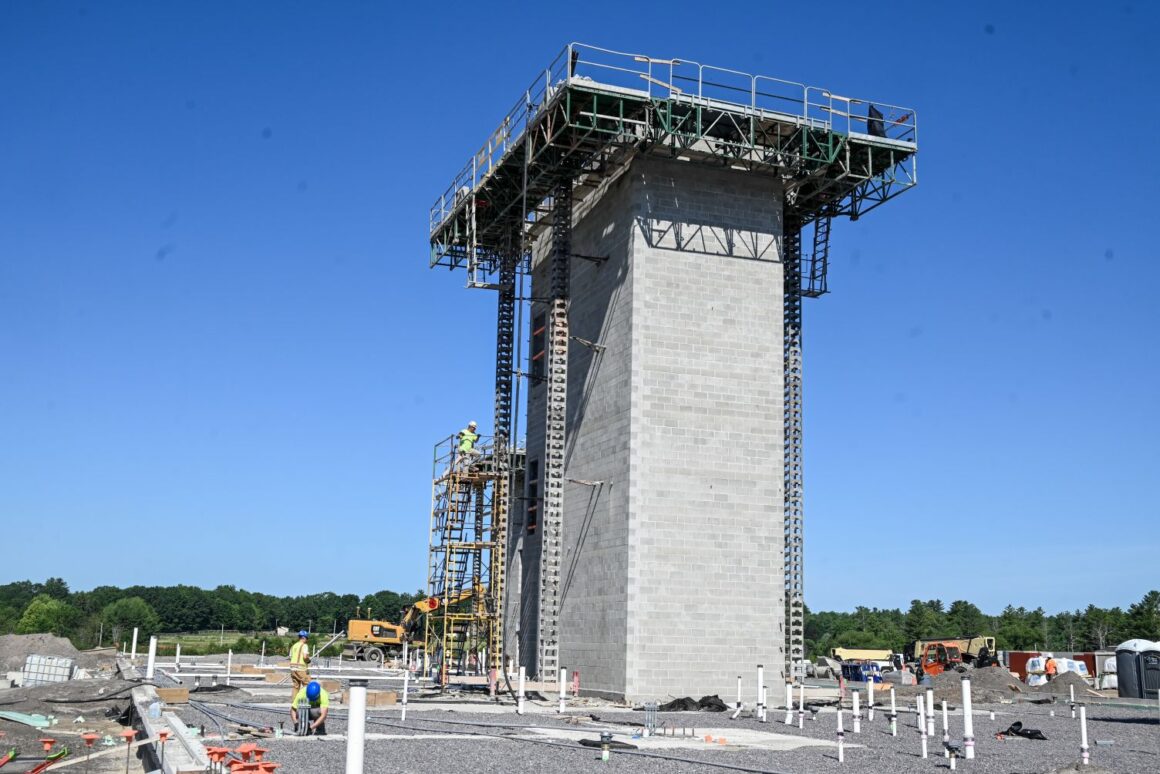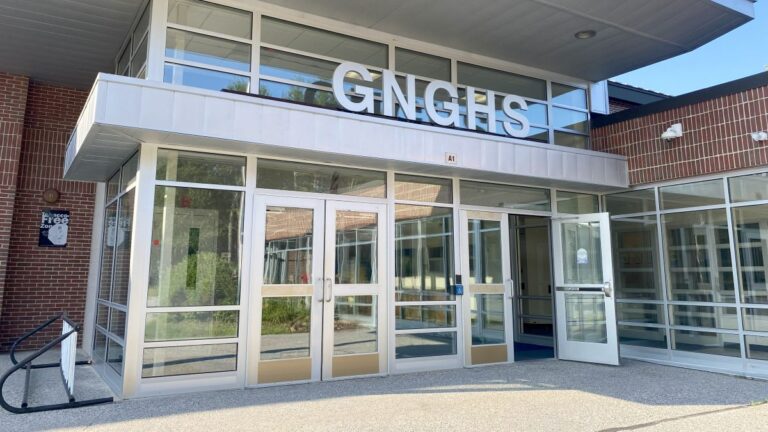RSU 14 Superintendent Chris Howell stepped through damp soil imprinted with tire treads from large construction vehicles as machinery whirred and beeped on a stretch of land near Sebago Lake. In a few years, the site will be home to a nearly $156 million middle school.
Howell said the project is necessary because one of the district’s two middle schools, a nearly 50-year-old building in Windham, has reached the end of its life and isn’t large enough to fit all its students: classrooms are too small and no longer meet the state standard for instruction, and the 1977 air and construction standards used for the original build are no longer sufficient. There is also little space for special education services like speech therapy.
“It also gave us an opportunity. Jordan-Small Middle School is a 1964 building, and those students will be consolidating in as well,” he said, referencing the district’s second middle school in Raymond. “For the first time, we’ll be able to offer equal programming to students in both Windham and Raymond.”
The project, which broke ground last fall, is the most expensive state-funded school construction project in Maine to date. The last school project to hold that title was Auburn’s Edward Little High School, which opened in 2023 and cost around $122 million, according to Department of Education records.
Many of Maine’s schools built between the 1950s and 1970s are starting to show their age, and communities must grapple with the hefty cost of replacing or maintaining these buildings. Some fund the projects entirely through local tax dollars, while others try their luck at getting state funding for a bulk of the costs.
But only a slim fraction of school construction projects win financial assistance – just nine of 74 applicants won state dollars in the last funding cycle, which occurs every seven years. This year, the state Department of Education received 94 applicants; awardees will be announced later this year.
A Maine Monitor analysis of state data from September shows that construction costs in Maine have risen in recent years: the cost per square foot to build an elementary school increased from $270 in 2015 to $661 in 2024. Costs across the country have spiked as well: In Massachusetts, several school construction projects in development are expected to exceed half a billion dollars, according to The Boston Globe.
Last year, Gov. Janet Mills established a commission to review school construction and financing for school renovations, acknowledging that “the need for construction and renovation of public school facilities across the State far outpaces available funding.”
Howell, who sits on the commission, said that he is looking at how to increase the funding available to help get expensive projects off the ground.
“What Maine’s going to have to figure out is, number one, how do we maintain all the square footage that we have,” Howell said, “but then also the process of prioritizing school funding for school projects — how do we do that moving forward, given that everybody right now is competing for resources at the state level?”
Budget breakdown
The new RSU 14 middle school site consists of wetlands, a former horse barn, a private soccer field, and a long-retired town gravel pit that held logs and deer carcasses before it was cleaned up for construction. The district paid about $1.7 million for the land.
Construction will cost around $123 million.
The contract, which is a fixed price unless the state or school were to request a large addition to the build, was awarded to Landry/French Construction, a company based in Scarborough that has handled multiple school projects across the state. As the general contractor, Landry/French subcontracts 40 companies who set their own bids for labor and materials.
Figuring out how much labor and materials will cost for the RSU 14 project is not easy to pin down.
Landry/French received multiple bids for trades needed on the project and evaluated the bids for “completeness,” the company’s COO Denis Garriepy explained, looking at whether or not the subcontractor will complete the full scope of the work, whether the price is reasonable, and whether the contractor has the resources to complete the work on time.
This process can take a month, Garriepy said, and then the general contractor puts in its bid for the school project, using the subcontractor figures. Labor and materials costs are not broken down in the subcontractor bids.
“From our perspective as a general contractor, it doesn’t actually matter, because we’re not buying drywall labor, we’re not buying drywall material – we’re buying the work,” Garriepy said. “And that holds true for every single trade, whether it’s masonry, drywall, paint, ceilings, electrical, mechanical. So that labor and material breakdown is not something we have or even need.”
Valerie Chiang, the Maine school construction coordinator with the state Department of Education, pointed out a few factors that have contributed to the rising cost of these projects. For one, Maine has limited staffing for construction projects, prompting companies to bring in labor from out of state and pay per diem rates for lodging and other costs.
Laborers must be paid prevailing wage rates for state public works contracts: in Cumberland County this year, a construction laborer makes a minimum hourly wage of $21.90. For an electrician, the minimum hourly wage is $37.43. Regulations and building codes also play a role: energy efficiency standards, for instance, demand an increase in insulation.
“It’s kind of an overall increase in everything,” Chiang said.
Still, the RSU 14 project has found savings along the way. The original estimate for the project amounted to $171 million, Howell said, but the district was able to shave around $16 million from the budget, in part through competitive bidding.
“In the world of tariffs and supply chain shortages and things, to be able to say we’re $16 million under budget at the moment is a place I didn’t think initially that we’d be at,” Howell said.
Howell said that the contractor will bear the responsibility of keeping things within budget if tariffs should raise material prices unexpectedly.
Garriepy said that Landry/French has seen an impact from tariffs on some of the materials used in the industry, including aluminum and steel products, but that pinning down how those changes will affect a particular project is difficult, noting that the impacts continue to be “volatile.”
The remainder of the project budget, about $33 million, included purchasing the land, establishing a project contingency budget, architectural and engineering services, and more.

Overall, the Windham middle school will have the highest state-funded project cost for each student since 1989: with a capacity for 1,200 students, the estimated cost per pupil for construction is around $130,000, according to state data. However, current enrollment data shows that the district has about 950 students in grades 5 through 8, putting the cost per pupil around $164,000.
While many rural school districts in Maine are facing declining enrollment, complicating the local school funding process, Howell said some increases in enrollment for the region are possible as more housing developments come to town.
Both of the district’s middle schools saw a decline in enrollment during the 2020-21 school year, but Jordan-Small Middle School’s enrollment now resembles pre-pandemic numbers. Windham Middle School has been declining slowly, despite a slight uptick in students this year compared to last. Enrollment across the entire district has declined slightly over the past decade, state data shows, from 3,175 in 2015-16 to 3,015 in the last school year.
Balancing state and local funding
Windham and Raymond residents are responsible for about $40 million of the price tag, with the state covering the other $116 million, or about 74 percent. The local contribution covers aspects of the school that go beyond core instruction, such as a greenhouse and a larger gym.
Howell pointed out that the local contribution often makes up for what the state cannot cover. For instance, the school district wants to build an auditorium in the middle school for about $13 million — a cost not covered by state funding.

The district also needs to cover the funding for common areas in the 12 classroom clusters that will be built throughout the school. Each of these spaces, which are about 900 square feet, will cost around $1 million.
Chiang said that what the state does and does not pay for in a project can boil down to whether that portion of the project is related to an extracurricular activity. Essentially, if a part of the project does not fall under the core instruction, the state may not fund it.
The most common things schools want that the state cannot support are athletic features, like larger gyms or bleachers, she said. Extra design features, such as curved walls or intricate floor patterns, are also not supported by the state.
Sometimes state funding limitations depend on the type of school: the state could give partial funding for an auditorium in a high school, for instance, but they don’t fund auditoriums for middle schools. RSU 14 voters still opted to move forward with the auditorium in the plan.
The new RSU 14 middle school, which is about two months of construction into its two-and-a-half year build, will replace two aging middle schools in the district. The move to combine both middle schools in RSU 14 was not part of the original plan, Howell said, who noted the initial project concept was submitted before he became superintendent.
The consolidated district came into existence in 2009, Howell said, and while Raymond has attempted to withdraw a few times in the past decade, he said that with this new project, both district towns will be locked in together for the next 20 years. For the annual bond payments of the $40 million local share, Windham will pay 82 percent and Raymond will pay 18 percent. This share of debt is based on enrollment, Howell said.
This is the school district’s first large-scale debt. The last school project in the region was the Windham high school, which was built in the early 2000s prior to district reorganization. It was one of the most expensive school construction projects at the time — costing about $35 million.
Clarification: The estimated cost per pupil has been updated to include all fifth graders in the district, as the new middle school will cater to all students in grades 5 through 8. That puts the number of students at 950 and the price per pupil at around $164,000, not $207,000 per student as originally stated in the article.







